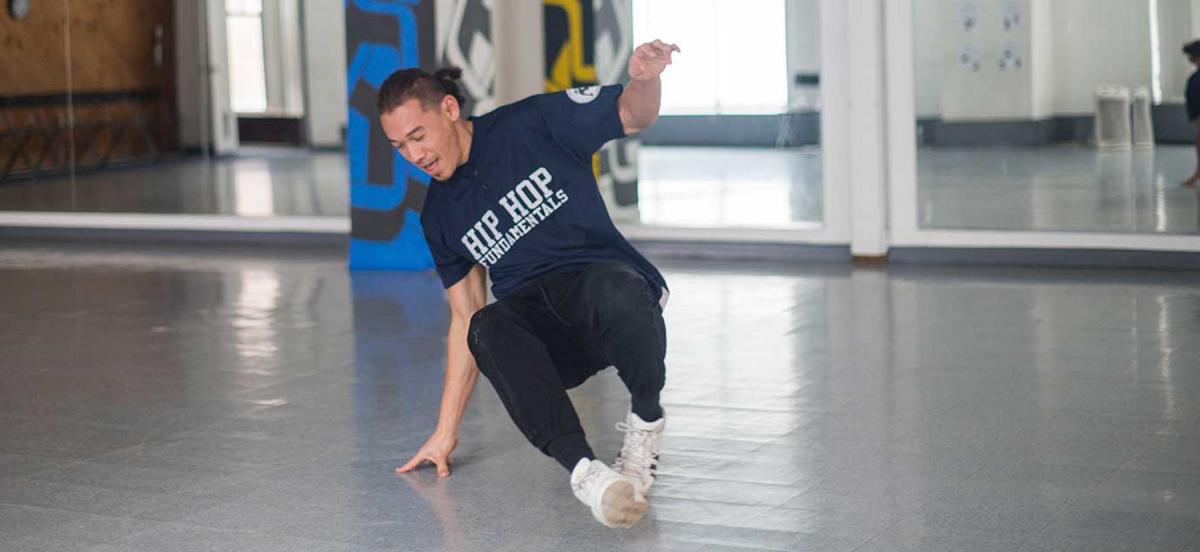Mark Wong '05 Teaches "Hip Hop Fundamentals"

Mark Wong '05. Photo by Patrick Montero.
Details
The Haverford English major who started a campus breakdancing club now uses breakdancing as a teaching tool in Philadelphia and New Jersey schools.
Imagine being an educator tasked with teaching basic physics, the history of the civil rights movement, and strategies for self-empowerment. If you asked Mark Wong ’05 how to get it all done, he’d have a one-word answer: breakdancing.
Wong is co-owner of Hip Hop Fundamentals (HHF), an educational group that uses breaking and hip-hop as teaching tools in school programs. “Breaking: The Laws of Physics” utilizes dancing human bodies to describe the molecular properties in states of matter; “Civil Rights Movements” touches on racism, segregation and student involvement in the struggles for freedom; and “Principles of Hip Hop” teaches hip-hop culture as a model for positive youth empowerment. But the programs HHF brings to approximately 100 Pennsylvania and New Jersey schools each year aren’t heavy going for kids. “Fun is the main ingredient,” says Wong. “I want our audiences to see a group of diverse breakers genuinely getting along while they defy gravity. I want students to join us onstage and realize that they, like the young pioneers of hip-hop, have the power to inspire others and create.”
Breaking is a dance style that requires serious focus and practice, with the body in near-constant motion. Pioneered in the mid-1970s Bronx and popularized with the rise of hip-hop music throughout the ’80s and beyond, breakdancers execute gravity-defying moves that can involve spinning on a single hand or the top of the head, mixed in with windmilling flips and joint-popping dance. Usually performed to a soundtrack of hip-hop, funk, and other beat-heavy music, breaking is all about joining the body and the rhythm in seemingly impossible ways.
Wong majored in English literature with a focus on minority and international writers. “But I suppose you could say I also studied breaking.” He started a breaking club on campus, spent most of his spare time practicing with friends and attending competitions, and experienced a revelation when he went to a show at Bryn Mawr featuring renowned hip-hop dance company Rennie Harris Puremovement. “It was the first time I ever saw professional hip-hop dancers onstage,” he says. “That was a pivotal and inspiring moment for me.”
He also discovered a great source of training in Philadelphia’s underground breaking scene, where dancers meet for practices at universities and dance studios as well as in secret sessions in train stations or parks. They organize monthly events like Second Sundae or The Gathering and yearly competitions such as the University of Pennsylvania’s Rhythmic Damage.
There was one barrier that he was pleasantly surprised to learn wasn’t present in the breaking world: Although breakdancing and hip-hop culture are predominantly African American forms, Wong found there was zero issue with a guy of Asian descent who grew up in Bermuda wanting to be a B-boy. “In fact, breakers of Asian descent are very well represented in the Philly, national, and international scenes.” He found that he was simply judged on his skills and dedication: “Real recognizes real.”
Wong lives in West Philadelphia with his wife, and in addition to his work with HHF, he teaches breakdancing at Movemakers Philly, a kids’ dance education program in Center City, and Urban Movement Arts, which offers classes to adults. Over the last several years, he’s also returned to campus regularly to give workshops for Haverford’s hip-hop dance group Bounce.
Through the classes and the Hip Hop Fundamentals programs, Wong is actively keeping the breakdancing scene and culture moving forward. “Every way in which breaking can function, from education and public performances to dance theater and the avant garde, is interesting to me,” he says.
And he especially wants to keep the traditions alive for the next generations of B-boys and B-girls. “I’ve been around long enough to confidently say that no matter what, [breakdancing] will never die,” he says. “There will always be the next kid who won’t stop practicing until they get that precious move.”



